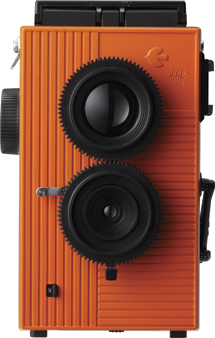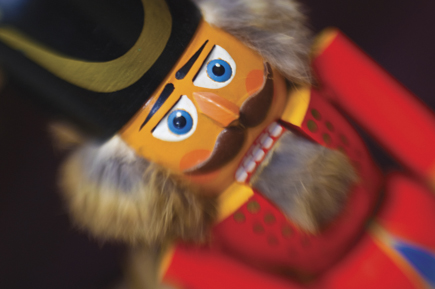While the digital trend may seem to add remarkable twist, what seems to be just a person's hobby in photography could kindle the spark for a new career break. - Scott Sohr
Low-Tech Cameras; Fine Art, Or Just Plain Fun Page 2
PowerShovel Cameras
PowerShovel is the newest contender in the low-tech camera market. These cameras are not really toys; the lens is too sharp, but they are most definitely low tech and fun to use. Their camera is called the Blackbird, fly after the Beatles song.
 |
|
|
|
 |
The Blackbird, fly is a Twin Lens Reflex (TLR) available in five colors. It can take pictures in standard 35mm film format (24x36mm), or by using a different (provided) mask, it can also produce square format pictures (24x24mm). You can remove the mask entirely and make a larger square format image (36x36mm), which fills up the entire width of the film, including the side sprocket holes.
For photographing during the day, you can alternate between f/7 and f/11, with a shutter speed of 1⁄125 sec. At night, you can switch the shutter to B-mode to let in as much light as you need, or you could attach a flash for even more possibilities. The Blackbird, fly uses a wide angle 33mm lens and allows you to take multiple exposure images.
 |
|
|
Pinhole Cameras
There are a number of pinhole cameras available, and even the Lomo and Holga don’t get more low tech than pinhole photography. Pinhole cameras came into existence several hundred years before the invention of photography as a means to project an image onto a wall or canvas. This was done for amusement at carnivals, and by artists to project an image they could trace in order to create realistic paintings.
Pinhole cameras come in a variety of film formats, from 35mm to 8x10”. Some of them come as build-it-yourself kits. The larger ones use either cut sheet film, Fujifilm FP-100C instant film, or both. The sheet film models will require the use of a large format film holder and a darkroom or commercial lab for processing.
 |
|
|
Lensbaby
There is no dedicated low-tech camera for digital photographers at this time. Perhaps Holga will someday make a digital model. But until then those who wish to remain purely digital have the Lensbaby line-up, which has a lens mount to fit almost any camera. Using the flexible selective-focus Lensbaby is a liberating experience for film or digital photographers who are fixated on their super-sharp lenses.
 |
|
|
|
 |
There’s Even A Book About Them!
If you want to learn more about low-tech cameras and see some fine examples of what you can do with them, pick up a copy of Michelle Bates’s book Plastic Cameras: Toying with Creativity, published in 2007 by Focal Press. The book can be ordered online at: www.toyingwithcreativity.com
 |
Just in case you are still doubting whether low-tech cameras are to be taken seriously, check out the Toy Camera website, www.toycamera.com. After you’ve made some images with your own low-tech camera you can enter the annual Krappy Kamera competition held annually by the Soho Photo Gallery, www.sohophoto.com, the oldest artist run photography gallery in New York City.
 |
|
|
Sources
While the Lomographic Society (www.lomography.com) distributes their extensive line of low-tech cameras, they can also be purchased in the US from Freestyle Photographic Supplies (www.freestylephoto.biz, (800) 292-6137). Freestyle also carries the Diana+, Holga, and all the pinhole cameras listed here.
Steve Anchell (www.steveanchell.com) is a writer and photographer who teaches darkroom and digital workshops from his home in Salem, Oregon. He will be teaching his popular five-day workshop “Alternative Large Format Techniques” for the Photographers’ Formulary Workshops in Montana from July 5-10, 2009.
- Log in or register to post comments


































